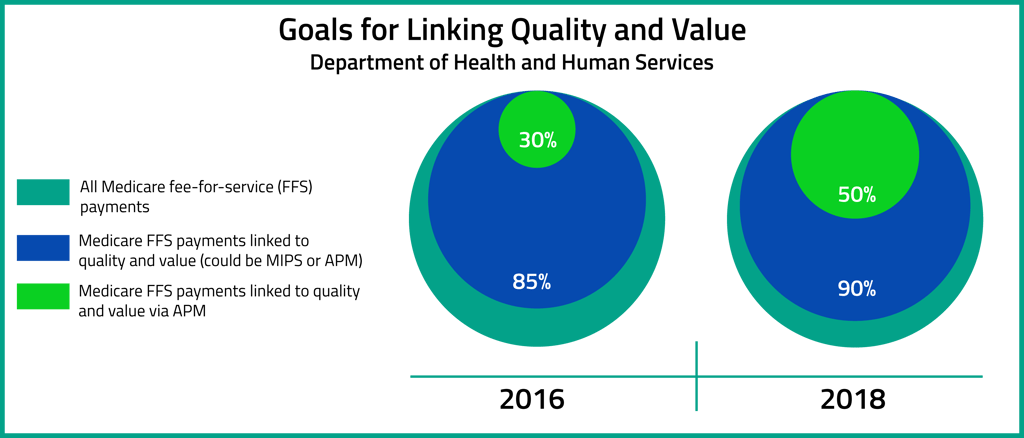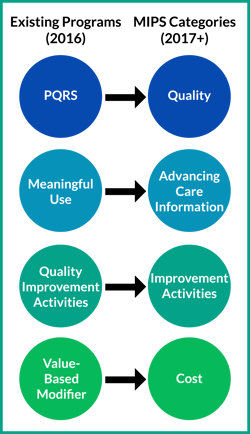

As it stands today, MACRA is broken into two eligibility pools, eligible clinicians participating in MIPS and eligible clinicians participating in an advanced Alternative Payment Model (APM). For this article, we are introducing MIPS, as CMS anticipates that 55% of MACRA eligible clinicians will be participating in MIPS rather than in an APM for the 2017 performance year. We will be publishing content explaining the mechanics of APMs under MACRA and how you can participate in the near future!
 In our upcoming MIPS series of articles, we’ll break down the 900+ pages (Yes, we read the entire document!) of regulations into bite-sized chunks that you can immediately use to start preparing. Whether the regulations take effect in six months or later, the sooner you prepare, the better you’ll do ‘on the curve’.
In our upcoming MIPS series of articles, we’ll break down the 900+ pages (Yes, we read the entire document!) of regulations into bite-sized chunks that you can immediately use to start preparing. Whether the regulations take effect in six months or later, the sooner you prepare, the better you’ll do ‘on the curve’.The proposed rule, titled "Medicare Program; Merit-Based Incentive Payment System (MIPS) and Alternative Payment Model (APM) Incentive Under the Physician Fee Schedule, and Criteria for Physician-Focused Payment Models," was published in the May 9 Federal Register. With a tentative start date of January 1st, 20173, this program may sound new and burdensome, but will be rewarding for physicians who optimize their results and reporting.
MIPS works by consolidating reporting into three pre-existing medical programs known as: Physician Quality Reporting System (PQRS), Value-based Modifier (VM), and Meaningful Use of Certified Electronic Health Record Technology (CEHRT). These will now be replaced by four performance categories: Quality (formerly PQRS), Resource use (formerly VM), Advancing Care Information (formerly the Meaningful Use of Certified EHR Technology); and Clinical Practice Improvement Activities (CPIAs, a new performance category).
Not Preparing for MACRA Will Be Detrimental
How much will your practice gain or lose from quality reporting? With the planned escalation of value-based programs like MACRA, the opportunity exists to significantly boost your revenue, or to see serious losses. Your reporting strategy today directly impacts your revenue potential over the next few years. MACRA alone will allow for a gain or loss of 9% of your Medicare Part B FFS reimbursements by 2022 (based on reporting done in 2020). Better preparing for MACRA now can set you up for success in the long haul. On the other hand, not adapting to new reporting will lead to substantial financial losses.
Table One: Maximum Penalties and Incentives under MIPS
|
Decile |
Points Awarded |
|
2017 |
2019 |
|
2018 |
2020 |
|
2019 |
2021 |
|
2020 |
2022 |
* 10% is the “exceptional performance bonus” currently proposed for MIPS
As we move into the second half of 2016, preparing for the impact of MACRA and Merit-Based Incentive Payment System (MIPS), may take up more time than even the most forward-thinking healthcare stakeholders predicted. Successful clinicians will increase their reimbursements. The funds to support incentives will come directly from reduced reimbursements to unsuccessful participants, as MIPS updates the payment model for clinicians in a manner that essentially ‘grades on a curve’. Don’t let that be you!
What You Can Do Now to Prepare for MACRA
Hopefully, I’ve showed you how ignoring MACRA now will only lead to scrambling down the road to prevent further losses, and how effectively strategizing for MACRA can catalyze your revenue. You may now be wondering what actions you can take now to be sure you stay ahead of the curve.
✅ Subscribe to our updates to stay informed of the latest versions of the proposed rule
✅ Find a partner for managing the Quality, ACI and CPIA aspects of MIPS (like MIPS PRO or a similar service)
✅ Look for our announcements regarding the final rule in fall of 2016
Being proactive now may seem like an unnecessary burden, but in 2022 when you are bringing in a 37% incentive to your Medicare billing and conquering any future value-based programs, I am positive it will seem worth the effort!
Sources / Footnotes:
1Via CMS
2Via Modern Healthcare
3Via Modern Healthcare: Andy Slavitt has recently reported to Senate that they are considering delaying MACRA implementation

